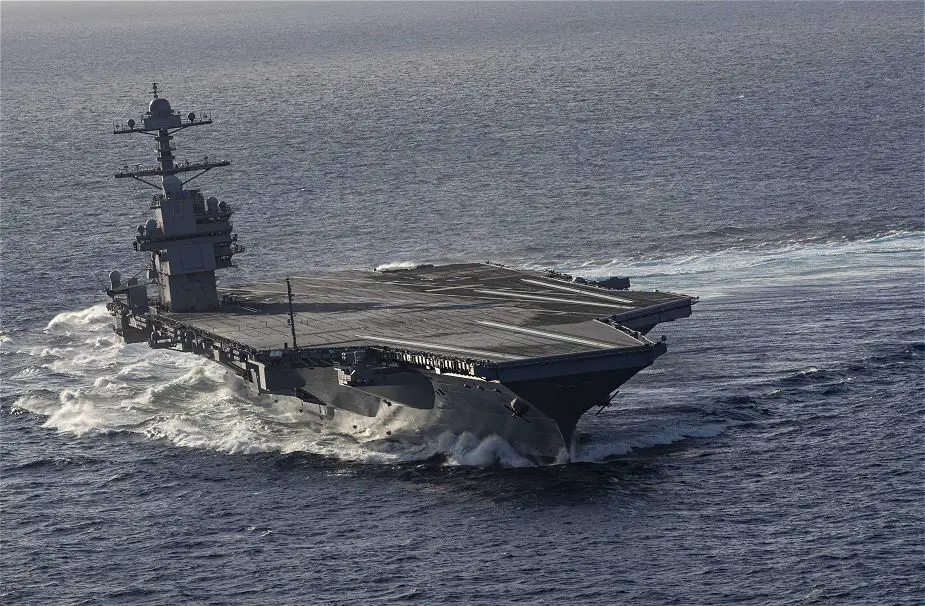Breaking news
US navy aircraft carrier USS Gerald R. Ford completes Post-Shakedown Availability.
U.S. Navy Program Executive Office (PEO) Aircraft Carriers announced the successful completion of the Post-Shakedown Availability/Selected Restricted Availability (PSA/SRA) for USS Gerald R. Ford (CVN 78) Oct. 30 as the ship returned to its home port at Naval Station Norfolk, Virginia.
 The aircraft carrier USS Gerald R. Ford (CVN 78) conducts high-speed turns in the Atlantic Ocean, Oct. 29, 2019. (Picture source U.S. Navy)
The aircraft carrier USS Gerald R. Ford (CVN 78) conducts high-speed turns in the Atlantic Ocean, Oct. 29, 2019. (Picture source U.S. Navy)
PSA completion marks a significant shipbuilding milestone for USS Gerald R. Ford, the first ship in a next-generation class that will serve for 50 years as the centerpiece of national defense in an increasingly complex security environment.
A PSA is a typical period of construction availability in the early life of a ship during which the Navy and shipbuilder resolve issues that arise during initial at-sea periods and make any needed changes and upgrades. The CVN 78 PSA began on July 15, 2018, and included work on Advanced Weapons Elevators (AWEs), repairs to the ship's main reduction gear, improvements to the throttle control system, upgrades to the Advanced Arresting Gear, and numerous other maintenance tasks.
During the PSA, most individual discrepancies, known as "trial cards," that had been identified during previous work-ups were successfully addressed, with very few remaining to address in future maintenance availabilities. As a first-of-class ship, such discrepancies are not unexpected, and the Navy is incorporating lessons learned from CVN 78 to inform design and actively improve oversight of future ships of the class.
In an emerging era of Great Power Competition, USS Gerald R. Ford will serve as the most agile and lethal combat platform in the world. The Gerald R. Ford class incorporates 23 new technologies, comprising dramatic advances in propulsion, power generation, ordnance handling and aircraft launch systems. These innovations will support a 30 percent higher sortie generation rate, executed with a 20 percent reduction in crew, at a significant cost savings, when compared to Nimitz-class ships. The Gerald R. Ford-class carrier offers a 17 percent reduction -- approximately $4 billion per ship -- in life cycle operations and support costs compared to the earlier Nimitz class.
Rutan praised the perseverance of thousands of designers, planners and technicians from PEO Aircraft Carriers, Naval Sea Systems Command, Naval Air Systems Command, Naval Information Warfare Systems Command, Naval Air Force Atlantic and the shipbuilder in methodically navigating through technical setbacks.
USS Gerald R. Ford (CVN-78) is the lead ship of her class of United States Navy aircraft carriers. Gerald R. Ford is intended to be the first of a class of aircraft carriers that offer significant performance improvements over the previous Nimitz class. Gerald R. Ford is equipped with an AN/SPY-3 and AN/SPY-4 active electronically scanned array multi-function radar,[58] and an island that is shorter in length and 6.1 m taller than that of the Nimitz class; it is set 43 m further aft and 0.91 m closer to the edge of the ship. Replacing traditional steam catapults, the Electromagnetic Aircraft Launch System (EMALS) will launch all carrier aircraft.
The USS Gerald R Ford can carry more than 60 aircraft. The Gerald R. Ford class is designed to accommodate the new Joint Strike Fighter carrier variant aircraft (F-35C).


























